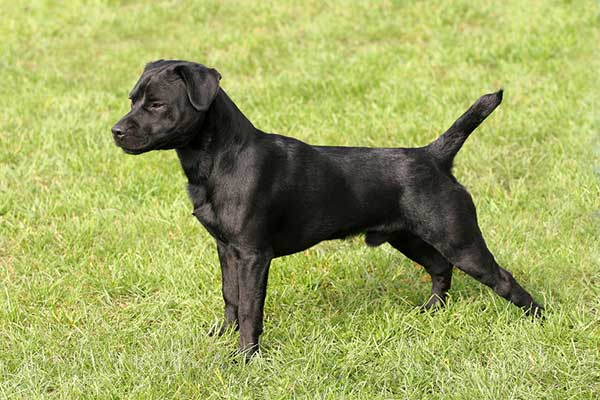
Patterdale Terriers are tough, energetic dogs that originated in Cumbria County’s Patterdale Valley. Even though it originated in the UK, it’s very popular in the US. A compact, confident, and independent dog bred to hunt foxes and rabbits. The name “Patterdale” comes from a chance encounter at a dog show in Patterdale.
Regardless of how big or small your family is, these cuties love attention – because they’ll demand it! The Patterdale Terriers don’t like being left alone for long, so large families might be best for them. It’s a high-energy dog and wouldn’t like a family with low energy. A big house with a backyard or countryside is ideal. They’re prone to tracking and wandering off, so ensure you have a secure yard.
Vital Stats:
- Dog Breed Group: Terrier Dogs
- Temperament: willful outgoing playful
- Height: 12 to 15 inches
- Weight: 11 to 13 pounds
- Life Span: 11 to 14 years
- Rare: No
- Coat: Short
- Grooming Requirements: Once a week
- Town or Country: Country
- Minimum Home Size: Small House
- Minimum Garden Size: Small to Medium Garden
- Breed Type: Pest Control Dog
- Size: Small
- Energy Level: High
- Exercise Required: Up to 1 hour
Patterdale Terrier Characteristics
- Patterdales are fearless and active. They love to play and get along well with kids and other dogs. They’re okay with cats if raised from a young age, but it depends on the dog.
- No doubt a novice dog owner can manage a Patterdale terrier, but this breed is generally recommended for people with some experience with dogs. Because of its stubbornness, highly energetic nature, and tendency to bark.
- The Patterdale terrier can live in apartments, but it’s not a good idea. While Patterdale terriers are small, they’re very energetic and loud. Your neighbors will be super frustrated even if you keep your dog well-exercised at home.
- They come in various colors, such as pied, black, red, and brown, and can be smooth, broken, or rough.
- The Patterdale Terrier is closely related to the Fell Terrier, bred in northern England to withstand harsh weather. A Patterdale Terrier can also handle heat and cold but should live indoors.
- Patterdale Terriers are prone to weight gain, so make sure they get at least one 30-minute to an hour-long walk a day, mixed in with some active play sessions and short walks.
- Allergy sufferers may not like these dogs, but their coat is pretty easy to maintain. You should brush them once a week to keep them in good condition.
- If they feel isolated, they’ll behave destructively. Don’t leave them alone for long periods. Families with lots of kids are great for this.
- Hunting is a Patterdale trait that can’t be controlled. They chase everything that moves, including cars, birds, and bikes. They need strict training to avoid accidents since they often get into trouble.
What was the purpose of breeding Patterdale terriers?
Patterdale Terriers were initially bred to hunt foxes, rodents, and other vermin to protect newborn lambs. The task required strength, stamina, intelligence, courage, and speed, and these dogs definitely met the requirements! While on the hunt, Patterdales were known to run down their prey at speeds up to 40 mph.
Are they recognized by the Kennel Club?
However, Patterdales are not very well known today because they were bred for hunting and not show. These dogs were first recognized by the Kennel Club in 1879 when it already had over 1000 members.
What 2 dogs make a Patterdale Terrier?
Originally, the Patterdale Terrier was bred from the Old English Terrier (the original black terrier) and the Northumberland Pit Terrier (extinct now); Patterdale Terrier got its start in the Lake District, specifically from Joe Bowman, a breeder of early Border Terriers at “Ullswater Hunt.”
Patterdale Terriers Appearance
Since Patterdale terriers are working terriers, they were bred for strength and stamina-not looks. There can be a lot of variation in their appearance.
A Patterdale terrier stands between 10-15 inches tall and weighs under 13 pounds. They’re strong, have long legs, and their triangular ears fold down. However, they look entirely different when it comes to their coat length, texture, and color.
They have a double coat and a short, dense undercoat. Depending on the type of top coat, they can be smooth, rough, wirehaired, or broken (also called broken). Smooth coats have coarse, dense, and stiff hair; broken coats have long, coarse, and wiry hair; rough coats have the longest and coarsest hair.
Black, red, liver, chocolate, grizzle, black and tan, and bronze are some of her coat colors. White markings can also be found on the chest and feet of Patterdale terriers.
Patterdale Terrier Temperament
Patterdale terriers are bold: these determined little dogs run for miles in pursuit of prey and work relentlessly to complete tasks. Also, they’re dogged in their quest for affection and approval, begging their owners for praise and treats.
Despite her intelligence and eagerness to please, the Patterdale terrier is active, independent, mischievous, and willful-so training and exercise are essential to keep her engaged.
They’re fun and like being around people, but they’re not too demanding of your attention after a long walk. You can keep them active with agility, flyball, and Terrier racing.
“Patterdales are very smart dogs that like to learn and have a job to do,” says Marissa Sunny, CPDT-KA, a canine behavior specialist at Best Friends Animal Society. “It’s important to keep them active and engaged.”
Patterdale terriers thrive with an experienced owner who can provide plenty of exercises, mental stimulation, and positive reinforcement training that they need.
Patterdales are loyal and affectionate dogs that need an active home.
Health
During the breed’s lifespan of 10-12 years, Patterdale terriers are susceptible to a few health problems.
Weight gain: Patterdale terriers are prone to obesity without enough exercise. A lot of health conditions are linked to obesity, from osteoarthritis to type 2 diabetes to heart disease. Make sure they get plenty of exercises to stay healthy.
Eye problems: The breed is prone to eye problems, including glaucoma, which happens when there’s too much pressure behind the eye. Squinting and watery eyes are common symptoms, and they can lead to blindness. Surgery and medication can ease pain and preserve vision in severe cases.
Joint problems: They’re prone to several joint diseases, including hip dysplasia, a painful condition that occurs when the hip joint does not fit into the socket, causing it to grind against the bone. Physical therapy and anti-inflammatory medications can usually treat hip dysplasia, but surgery may sometimes be needed.
Do Patterdale terriers make good pets?
Today, Patterdale terriers are known as pets rather than working canines. The ones that are working dogs are usually ratters on farms. That’s because fox and badger hunting is now illegal in England. However, they can be used for ‘bushing’ and ‘flushing out prey.
Those who own this breed of dog now keep them to enjoy their intelligence, love of play and friendly nature. They are not the type of canine to bark constantly or jump all over guests, but they will alert their owner when there is a guest at the door with a deep and resonant bark.
These dogs make great companions to those who have just moved into new territory because they will happily track down any critter that comes into their territory, and they may also prevent other wild animals from moving in if they feel as though their owner is threatened. They are great little watchdogs!
What is the coat of a Patterdale terrier-like?
Patterdale terriers can have either short or long coats, but the amount of maintenance required will be the same for both types. The fur on Patterdale’s body is short and smooth, while the fur on the head and legs is longer. Therefore, this breed of dog has a double coat comprised of a soft undercoat and stiff guard hairs. The color combinations that are most common for Patterdale Terriers are black and brown, while some markings include light or dark patches on the cheeks, chest and feet. However, it must be understood that the color of a dog’s coat is not always an indicator of its quality or temperament.
Do they shed?
Patterdale Terriers do not shed as much as other breeds, but they will shed twice per year. The hair that is lost will need to be collected with a lint roller and disposed of in order for the home to remain clean. These dogs are known for having a musky smell, but it is not because their fur stinks – it is simply because their coat produces very little oil.
Grooming Patterdale terriers
Dog breeds that have hair that grows quickly will need to be brushed every week or so, but Patterdale terriers only require this type of maintenance once every few months. Once every three months or so, a professional groomer will need to cut the hair over their eyes to make sure that it does not become tangled and matted. Some owners enjoy this type of maintenance, but Patterdale terriers are often fine with just being clipped by a pro once per year for those who find it difficult to handle.
They love to play!
It must be understood that Patterdale terrier owners may need to purchase toys throughout the year because their breeds love to play and have a good time. It is not uncommon for these dogs to make their own toys out of small sticks and balls, but they will always appreciate new things that are stuffed with treats.
How much exercise do they need?
Patterdale terriers may be kept in an apartment, but these dogs are diggers, and they may use this skill whenever the mood strikes them. It is recommended that this breed of dog stays in a home with at least a medium-sized yard to run around in. Owners who live in apartments or houses should take the time to walk their canine companions for at least 20 minutes twice per day.
Extended weekend walks and hikes should enhance this daily exercise regime. A Patterdale will have no problem hiking up a hill or mountain with you for 3 hours!
Keeping your Patterdale Healthy
Patterdale Terriers are susceptible to hip dysplasia, eye problems such as juvenile cataracts, and subaortic stenosis. They also have a chance of getting heart problems. As with all dogs, they will need regular worming, flea treatment, and vet checkups. In addition, they will need the usual vaccinations to protect them against dog diseases such as Canine Distemper and Parvovirus regarding vaccinations.
Training
These dogs have a reputation for being stubborn, so patience is key to training them. However, they’re cute and affectionate, and their primary caregiver will form strong bonds with them.
Patterdale terriers are feisty, stubborn, and prey-driven, so socializing and training them at a young age is important. Socialize them with other puppies as soon as they have had their injections. If you adopt an adult Patterdale terrier, you can train them with positive reinforcement methods such as clicker training – they respond very well to this.
Do you have a Patterdale? If so, we’d love to hear about it! Please feel free to leave a comment on our blog!
Care
Patterdale terriers don’t need much grooming. Their short, dense coats need to be brushed about once a week (more in the summer, when they shed more), and their coats don’t need to be trimmed. Patterdale terriers only need to be bathed once a month to keep their odor at bay.
In order to keep them flea-free, tick-free, and heartworm-free, Patterdale terriers need high-quality diets, regular vet care, and preventive medicine.
Exercise and training are the two biggest time and effort investments you can make when caring for a Patterdale terrier. They’re working dogs who love to work, Sunny says. To help Patterdale terriers learn new tricks, focus on fast-paced, interactive games that provide physical and mental stimulation.
Related links:



